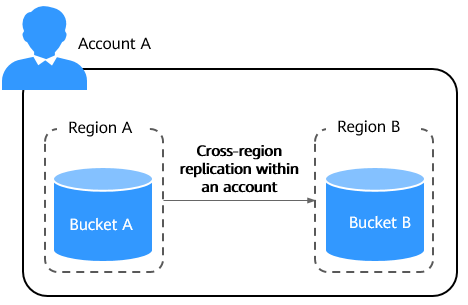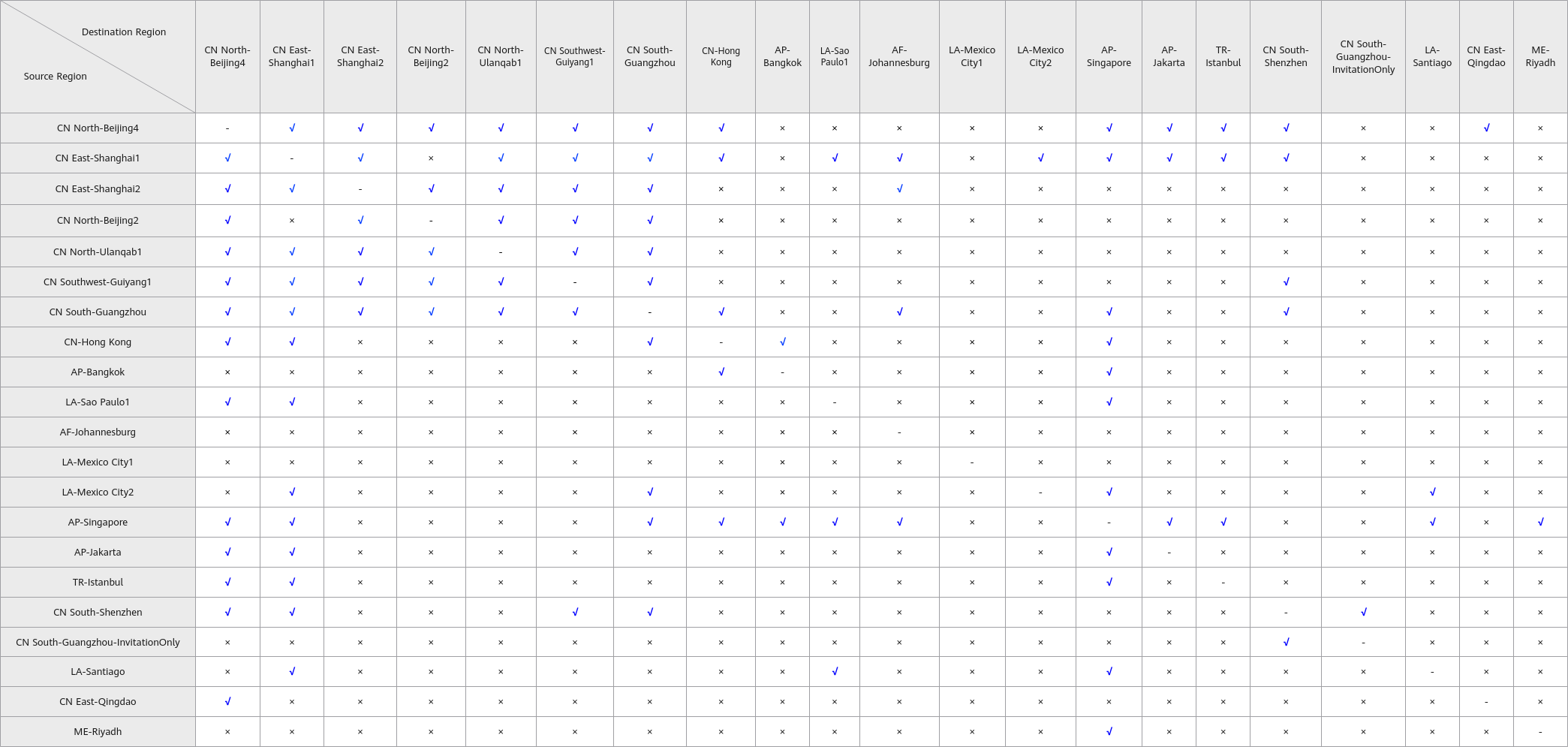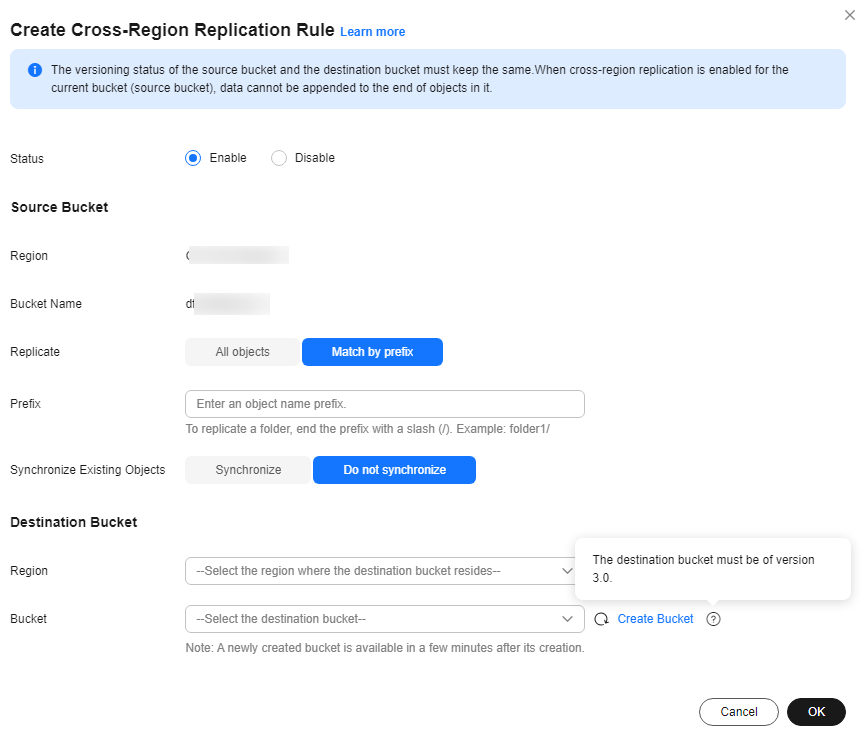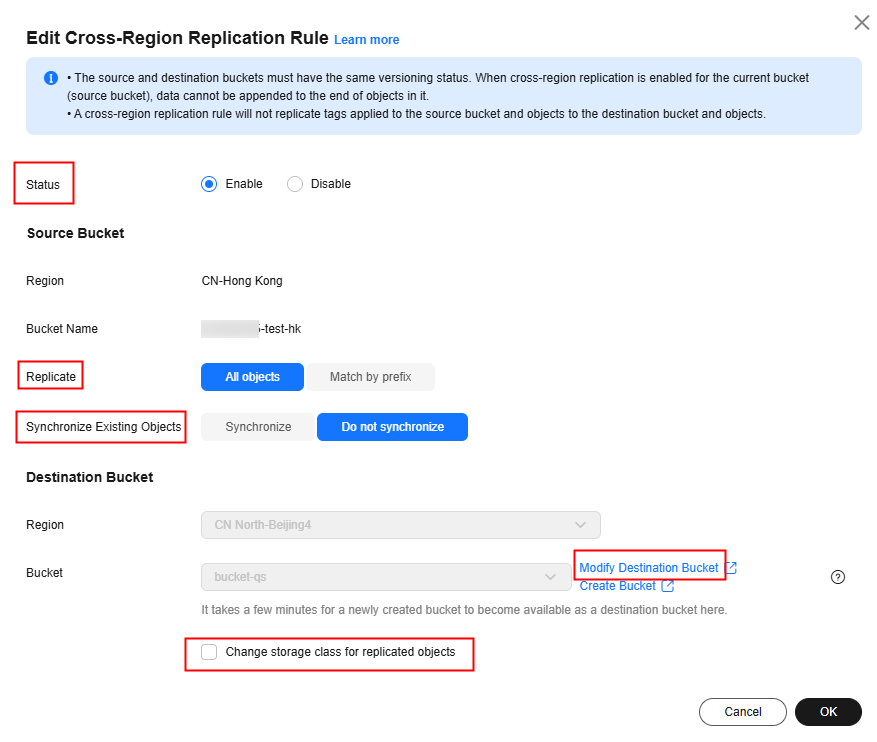Cross-Region Replication Within an Account Using OBS
Scenarios
Cross-region replication within an account allows you to define replication rules that automatically replicate data from a source bucket in one region to a destination bucket in another region under the same account in near real time. Objects replicated to the destination bucket are exact copies of the objects in the source bucket.
This section describes how to replicate data between buckets of the same account across regions using OBS Console, OBS APIs, or obsutil.
Replication scope: objects with a specified prefix or all objects in a bucket
Replication content: object content, metadata (object name, size, last modification time, creator, version number, and user-defined metadata), ACL, and storage class (under the default configuration)

If Change storage class for replicated objects is selected when you create a cross-region replication rule, the storage class of the object copies is different from that of the source objects.

You can use cross-region replication within an account to meet the following requirements:
- Regulatory compliance
By default, OBS stores data across AZs that are relatively far apart from each other. However, regulatory compliance may require data to be stored at even greater distances. In such cases, you can use cross-region replication to meet compliance requirements.
- Low latency
The same OBS resources may need to be accessed from different locations. To minimize the access latency, you can use cross-region replication to create object copies in the nearest region.
- Data replication
You want to migrate data stored in OBS to the data center in another region.
- Data backup and disaster recovery
For security and availability purposes, you want to create explicit backups for all data written to OBS in the data center of another region to ensure data remains available if there is any damage.
- Easy maintenance
You have compute clusters used to analyze the same group of objects in two different OBS regions and may need to maintain object copies in these two regions.

OBS helps you replicate your service data stored in OBS to a specified region. However, Huawei Cloud does not have visibility into your data and is not responsible for ensuring the legal compliance of your use of OBS. If your replication involves cross-border transfer, ensure that your use complies with relevant laws and regulations.
Constraints
|
Item |
Description |
|---|---|
|
Bucket version |
Only buckets whose version is 3.0 or later support cross-region replication. The version of a bucket can be viewed in the Basic Information area of the bucket's Overview page on OBS Console. For details, see Viewing Bucket Information. |
|
Functions |
|
|
Time |
A cross-region replication rule may not take effect immediately upon its configuration. Accordingly, the objects that this rule is applied to may not be replicated immediately after the rule is configured. |
|
Region |
|
|
Synchronization of existing objects |
|
|
Versioning |
|
|
Access control |
|
|
Tags |
A cross-region replication rule will not replicate tags applied to the source bucket and objects to the destination bucket and objects. |
|
Others |
|
Important Notes
- After a bucket is created, you are advised to wait at least 5 minutes before creating a cross-region replication rule for the bucket, or the rule creation may fail.
- If the cross-region replication rule is enabled but the function of synchronizing existing objects is disabled, there is a delay of about five minutes to apply the rule. Objects uploaded during that delay may not be replicated.
- If the cross-region replication rule and the function of synchronizing existing objects are both enabled, existing objects will be replicated 5 minutes later.
- Objects encrypted with server-side encryption (including SSE-KMS and SSE-OBS) can be replicated. The replication traffic cost is calculated based on the length of the plaintext for SSE-KMS and SSE-OBS. For details, see Billing for Cross-Region Replication Within an Account.
Billing for Cross-Region Replication Within an Account
Figure 3 shows the items that will be billed when data is replicated from one region to another.
|
Action |
Billing Item |
Description |
Billing Mode |
|---|---|---|---|
|
Replicate data across regions |
Requests |
You are billed for the number of successfully replicated objects. Successfully replicating one object creates a copy request. For details, see Copying Objects.
For details about how requests are billed, see Requests. |
Pay-per-use |
|
Data transfer |
Traffic generated when you replicate data from the source bucket to the destination bucket in another region. Billing only applies to the data transferred out of the source bucket. If objects are encrypted using server-side encryption, the cost of their cross-region replication traffic is calculated based on the length of the plaintext for SSE-KMS and SSE-OBS. |
Pay-per-use |
|
|
Storage space |
Space occupied by the replicated objects in the destination bucket If you have specified another storage class for object copies in the destination bucket, these copies are billed based on the new storage class. If objects are encrypted using server-side encryption, their storage cost is calculated based on the length of the ciphertext. |
Pay-per-use Resource packages |
|
|
Synchronize existing objects |
Requests |
You are billed for the number of existing objects that are successfully replicated to the destination bucket. Billing applies to the number of objects that are successfully replicated. You are also billed for listing the existing objects. |
Pay-per-use |
|
Data transfer |
Traffic generated when OBS replicates existing objects to the destination bucket in another region. Billing only applies to the data transferred out of the source bucket. If historical objects are encrypted using server-side encryption, the cost of their cross-region replication traffic is calculated based on the length of the plaintext for SSE-KMS and SSE-OBS. |
Pay-per-use |
|
|
Storage space |
Space occupied by the replicated objects in the destination bucket If you have specified another storage class for object copies in the destination bucket, these copies are billed based on the new storage class. If historical objects are encrypted using server-side encryption, their storage cost is calculated based on the length of the ciphertext. |
Pay-per-use Resource packages |
Prerequisites
- There is a source bucket in a region of an account. The bucket version is 3.0 or later, and the bucket region supports cross-region replication.
- There is a destination bucket in another region of the same account. To create a bucket, see Creating a Bucket.
Creating a Rule for Cross-Region Replication Within an Account
You can use OBS Console, APIs, or obsutil to configure cross-region replication within an account.
Editing, Disabling, Enabling, or Deleting a Cross-Region Replication Rule
You can use OBS Console or APIs to manage cross-region replication rules.
References
Feedback
Was this page helpful?
Provide feedbackThank you very much for your feedback. We will continue working to improve the documentation.See the reply and handling status in My Cloud VOC.
For any further questions, feel free to contact us through the chatbot.
Chatbot









